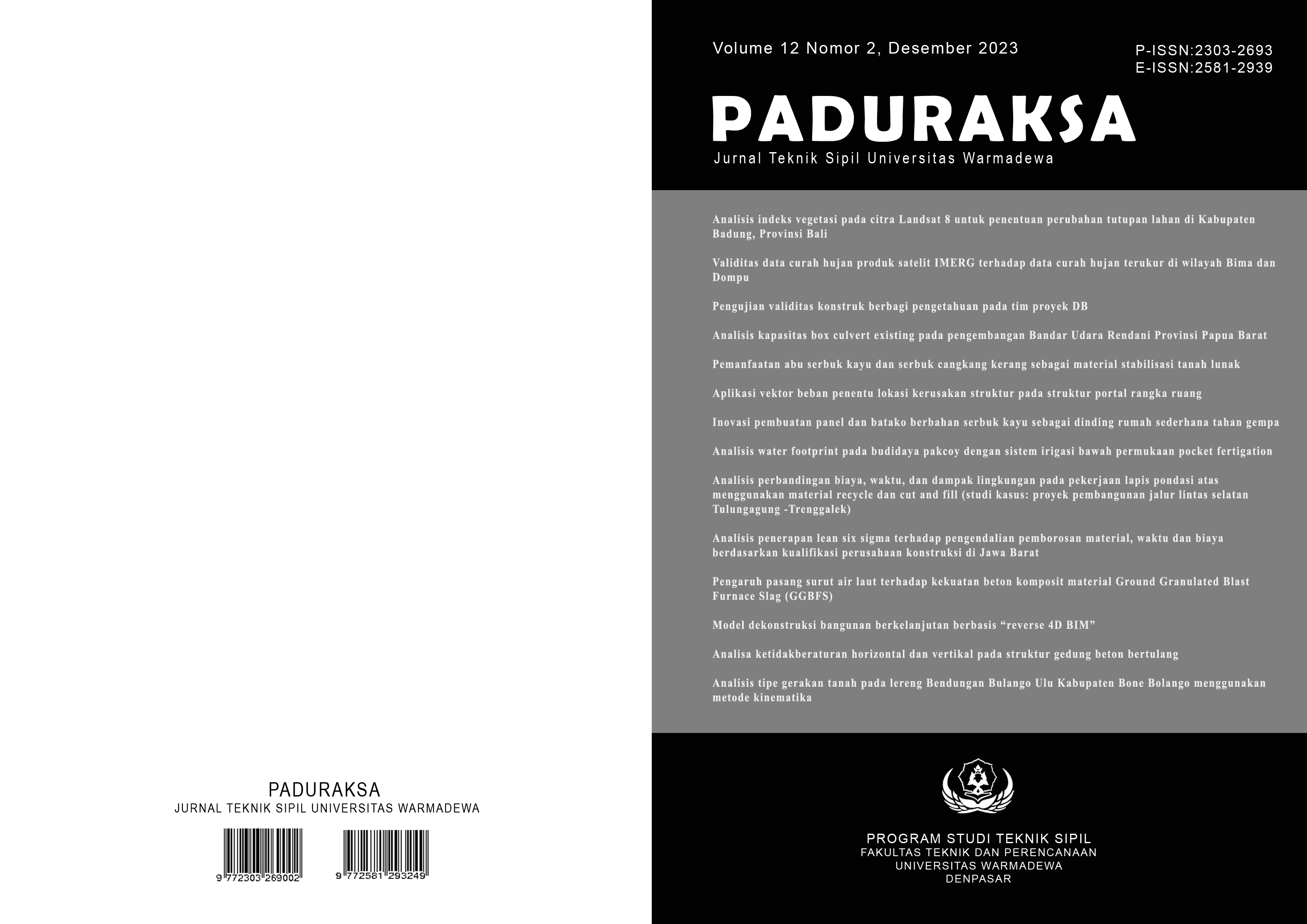Inovasi pembuatan panel dan batako berbahan serbuk kayu sebagai dinding rumah sederhana tahan gempa
Abstract
The number of poor people in Indonesia in March 2021 was 27.54 million people. One indicator is that people do not yet have decent homes. The income of the poor is generally below average, resulting in difficulties in accessing housing loans from banks. All parties must contribute in helping the poor to have livable houses. Researchers innovate to make simple houses livable based on Appropriate Technology, namely technically meeting safety, economical and affordable, ergonomic according to occupant anthropometry, fulfilling socio-cultural standards so that they can be accepted by the community and are energy efficient and sustainable. The innovation of using panels or bricks from sawdust for the walls of a simple house with a size of 3 m x 6 m that was built according to Appropriate Technology methods meets feasibility. The maximum stress ratio of 0.534 occurs in the column and is smaller than the required 1.0. The maximum deviation that occurs at the top of the building is 5.91 mm and is smaller than 0.02 times the total height of the building, namely 0.02 times 4000 is 80 mm. Measurement of the intensity of natural lighting during the day obtained 338 Lux, room temperature obtained 25.56°C, air humidity (RH) 71.62%, and air movement 0.15 m/sec and noise 36.82 dB. The contribution of this research is to provide a new wall material solution for simple houses, namely walls made from panels and bricks made from wood powder.
References
Anggraeni, L. K. (2017). Kajian Penerapan Ergonomi dalam Perancangan Bangunan Sekolah Dasar, Studi Kasus SDN Bubutan IV Surabaya. Jurnal Desain Interior, 2(1), 43. https://doi.org/10.12962/j12345678.v2i1.2378
BPS. (2020). Statistik Indonesia. Badan Pusat Statistik. https://www.bps.go.id/publication/2020/04/29/e9011b3155d45d70823c141f/statistik-indonesia-2020.html
BSN. (2018). SNI 1727-2018 tentang beban desain minimum dan kriteria terkait untuk bangunan gedung dan struktur lain. Badan Standardisasi Nasional.
BSN. (2019). SNI 1726:2019 tentang tata cara perencanaan ketahanan gempa untuk struktur bangunan gedung dan nongedung. Badan Standardisasi Nasional.
Hermawati, W., Sutarja, I. N., & Nadiasa, M. (2015). Evaluasi Pelaksanaan Program Bantuan Perbaikan Rumah untuk Rumah Tangga Miskin (RTM) di Kota Denpasar. Jurnal Spektran, 3(2), 75–83. https://doi.org/10.24843/SPEKTRAN.2015.v03.i02.p09
Kroemer, K. H. E., & Grandjean, E. (2000). Fitting the Task to the Man: A Textbook of Occupational Ergonomics (8th ed.). Taylor & Francis.
Lippsmeier, G. (1994). Bangunan Tropis. Erlangga.
Mangunwijaya. (1981). Pasal-Pasal Penghantar Fisika Bangunan. Gramedia.
Manuaba, A. (2006). Aplikasi ergonomi dengan pendekatan holistik perlu, demi hasil yang lebih lestari dan mampu bersaing. Jurnal Ilmiah Sosial & Humaniora, 2(3), 235–250.
Meijs, ing P. J. M. Van Der. (1983). Membangun : Fisika Bangunan. Erlangga.
Paresa, J., & Hairulla, H. (2015). Perlakuan campuran batako dengan menggunakan abu sekam padi sebagai bahan aditif. MUSTEK ANIM HA, 4(3), 264–272. https://doi.org/10.35724/mustek.v4i3.483
Pheasant, S. (1991). Ergonomics, Work and Health. Macmillan Education UK.
Radjasa, O. K. (2020). Panduan Program Penerapan Teknologi Tepat Guna kepada Masyarakat. Direktur Riset dan Pengabdian Kepada Masyarakat, Deputi Bidang Penguatan Riset dan Pengembangan, Kementerian Riset dan Teknologi/ Badan Riset dan Inovasi Nasional.
Rahmiyati, N., Andayani, S., & Panjaitan, H. (2015). Model pemberdayaan masyarakat melalui penerapan teknologi tepat guna di Kota Mojokerto. JMM17 : Jurnal Ilmu Ekonomi Dan Manajemen, 2(02), 48–62. https://doi.org/10.30996/jmm17.v2i02.506
Rantung, C. M., Sumajouw, M. D. J., & Windah, R. S. (2014). Evaluasi balok dan kolom pada rumah sederhana. Jurnal Sipil Statik, 2(6), 301–309.
Suma’mur, P. K. (1996). Ilmu hygiene perusahaan dan kesehatan kerdja. Doa Restu.
Sutarja, I. N. (2013). The Application of Brick Wall and Bamboo Reinforced Concrete Frame for Redevelopment of Traditional Houses in Pengotan Village. Key Engineering Materials, 594–595, 477–481. https://doi.org/10.4028/www.scientific.net/KEM.594-595.477
Sutarja, I. N. (2018). Safe, Simple and Comfortable House with Bamboo Reinforced Concrete Structure. In Bamboo - Current and Future Prospects. InTech. https://doi.org/10.5772/intechopen.68543
Sutarja, I. N., Ardana, M. D. W., & Putra, I. D. G. A. D. (2021). The Post-disaster House: Simple Instant House using Lightweight Steel Structure, Bracing, and Local Wood Wall. International Journal of Engineering, 34(2), 348–354. https://doi.org/10.5829/ije.2021.34.02b.06
Sutarja, I. N., & Putra, I. D. G. A. D. (2022). Ergonomics in the Contemporary Balinese Building: the Integration between Architectural and Structural Aspects. Civil Engineering and Architecture, 10(2), 501–512. https://doi.org/10.13189/cea.2022.100210
Winarno, B. (2018). Evaluasi program penyediaan rumah layak huni bagi masyarakat miskin di Kabupaten Belitung. Jurnal Pengembangan Kota, 6(1), 66. https://doi.org/10.14710/jpk.6.1.66-74
Zuraida, S., & Pratiwi, S. (2020). Panel Komposit Limbah Serbuk Kayu sebagai Alternatif Komponen Bangunan Ramah Lingkungan. Journal of Applied Science (JAPPS), 2(1), 061–066. https://doi.org/10.36870/japps.v2i1.162
Authors who publish with this journal agree to the following terms:
- Authors retain copyright and grant the journal right of first publication with the work simultaneously licensed under a Creative Commons Attribution License that allows others to share the work with an acknowledgement of the work's authorship and initial publication in this journal.
- Authors are able to enter into separate, additional contractual arrangements for the non-exclusive distribution of the journal's published version of the work (e.g., post it to an institutional repository or publish it in a book), with an acknowledgement of its initial publication in this journal.
- Authors are permitted and encouraged to post their work online (e.g., in institutional repositories or on their website) prior to and during the submission process, as it can lead to productive exchanges, as well as earlier and greater citation of published work (See The Effect of Open Access).
 Abstract viewed = 126 times
Abstract viewed = 126 times
 PDF downloaded = 212 times
PDF downloaded = 212 times










